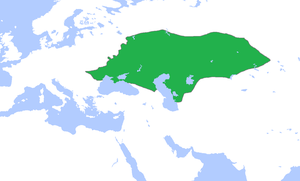Simsir
Kingdom of Simsir | |
|---|---|
| 1362-1395 | |
 Simsir | |
| Common languages | |
| Religion | Eastern Orthodox Church Sunni Islam Vainakh religion |
| Government | Elective monarchy |
• 1362–1395 | Khour Ela |
| Today part of | Russian Federation |
Simsir was a kingdom in Chechnya during the Middle Ages, existing in the 14th century. It was located roughly in Eastern Chechnya (Ichkeria,[1] roughly where the modern districts of Gudermes and Nozhay-Yurt lie today, around the Sunzha and Terek rivers).[2] Its name may have been derived from the Chechen town of Simsir.[3] According to folklore, the King Gayur Khan was chosen as the leader of all Chechens by the Mehk-Khel (National Council). In its later years, it allied itself with the Golden Horde before being destroyed in 1395 by Timurlane.
Society[]
Simsir existed at a time when Chechens had a feudal system; in the early modern era, they overthrew their feudal rulers in a "revolutionary" event and established in its place a quasi-democratic taip system by which representatives of taips voted in a national council[4] but while this differentiated Chechens from their neighbors more recently, it was not the case in the Middle Ages when Simsir existed.
During the Middle Ages, Chechen societies such as Simsir had a hierarchical and pyramidal structure. The Principality of Simsir's prince (the eela) sat at the top, followed by nobility and vassals (uzden), followed by free commoners (halxoi), followed by servants (yalxoi, including gharbashash, i.e. bond women), followed by serfs (lesh, lai in the singular), with only slaves and war captives (yiisarsh) beneath them; additionally, clerics were placed in the uzden nobility class. The wife of a prince was called a stuu and addressed as stulla.[5]
Alliance with the Golden Horde[]

In the 14th century, its rulers became tributaries of the Golden Horde, which brought Islamic influence with it. The ruler of Simsir was a powerful prince called Gayur Khan from the Sado-Orsoy clan. He was a Christian ruler who was very close to the Khan Khidir, who at times used him as an ambassador to the Rus cities for negotiations and peace. After the death of Khan Khidir, the Golden Horde fell into chaos for over 20 years. One of the main figures of this era was the warlord Mamai, who was defeated by a Chechen army led by Gayur Khan in 1362.[6] This is believed to have resulted in an independent Simsir kingdom ruled by Gayur Khan. He was also an important ally to Khan Tokhtamysh, which is seen from the 18th century manuscript by the general Sultan Kazi-Girey which notes that the Chechens were in the vanguard of the Tokhtamysh against the Timurid Empire during the Battle of the Terek river. The defeat of the Golden Horde led to disastrous consequences for the Simsir kingdom as Timur decided to invade due to their alliance with Tokhtamysh.[7][6]
Timurid Invasion[]
In the reign of its last ruler, Gayur Khan, the Principality of Simsir was destroyed by Timurlane in 1395 as part of his campaign against the Golden Horde. Its population fled south, into the mountains, in order to escape the attacks of the Mongols.[8] In the Zafarnama, it states that Timurlane chased these escapers south into the mountains and subdued them.[7] Timur placed Makhama, the son of Gayur Khan as Vassal and converted him to Islam. The fate of Makhama is described in Chechen folklore collected by the Sadoy clan historian Murtazaliev. Makhama was assassinated by the Chechens that replaced him with the previous ruler Gayur Khan, who continued to resist Timur until he was treacherously murdered during the negotiations by the Timurids.[9]
References[]
- ^ Этническая история Северного Кавказа X—XIII вв. — СПб. : Изд-во С.-Петербург. ун-та, 1994. — с. 236 — ISBN 5-288-01010-2
- ^ Jaimoukha, Amjad. The Chechens. Page 34
- ^ Сигаури И. М. Очерки истории и государственного устройства чеченцев с древнейших времен. — М. : ИД «Русская жизнь», 1997 — с. 365
- ^ Jaimouhka, Amjad. The Chechens: A Handbook. Page 89
- ^ Jaimoukha, Amjad. The Chechens : A Handbook. Page 276
- ^ a b Tesaev, Amin (2018). "Симсим". РЕФЛЕКСИЯ. 2: 61–67.
- ^ a b Sharaf ad-Din Ali Yazdi (2008). Zafar Nama (Book of the victories of Amir Timur, translated from Persian to Uzbek by Muhammad Ali ibn Darvesh Ali Bukhari (16th century)). Tashkent: Academy of the Sciences of the Republic of Uzbekistan. "Abu Rayhan Beruni" Institute of Oriental Studies. SAN'AT. p. 203.
- ^ Jaimoukha, Amjad. The Chechens. Pages 35-36
- ^ Муртазалиев, В. К вопросу об истории государства и права чеченцев.
- Golden Horde
- History of Chechnya
- Principalities